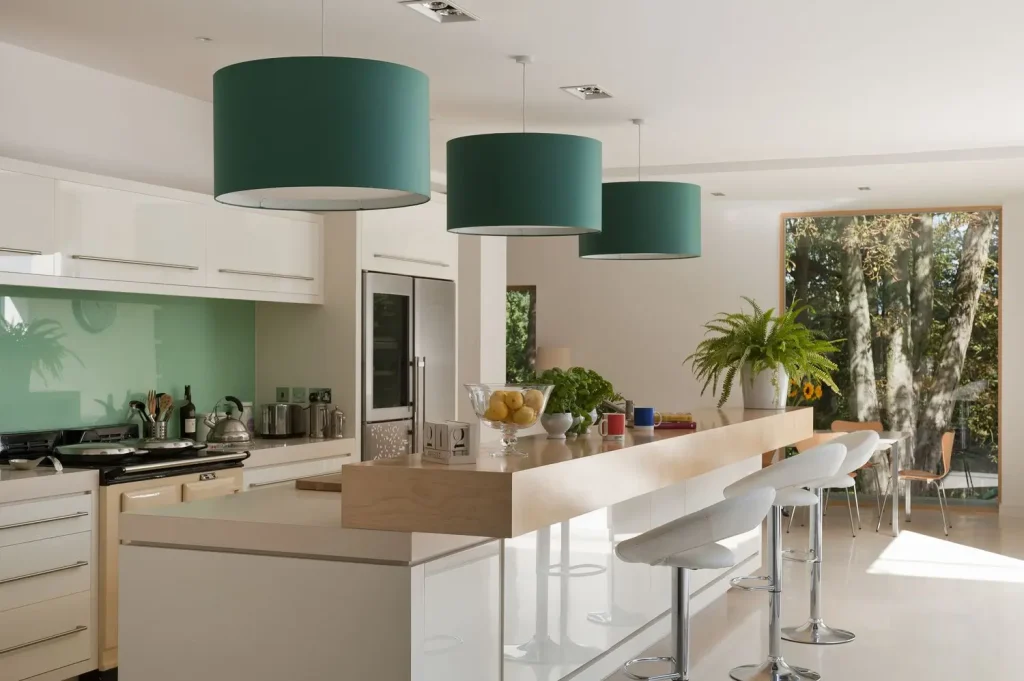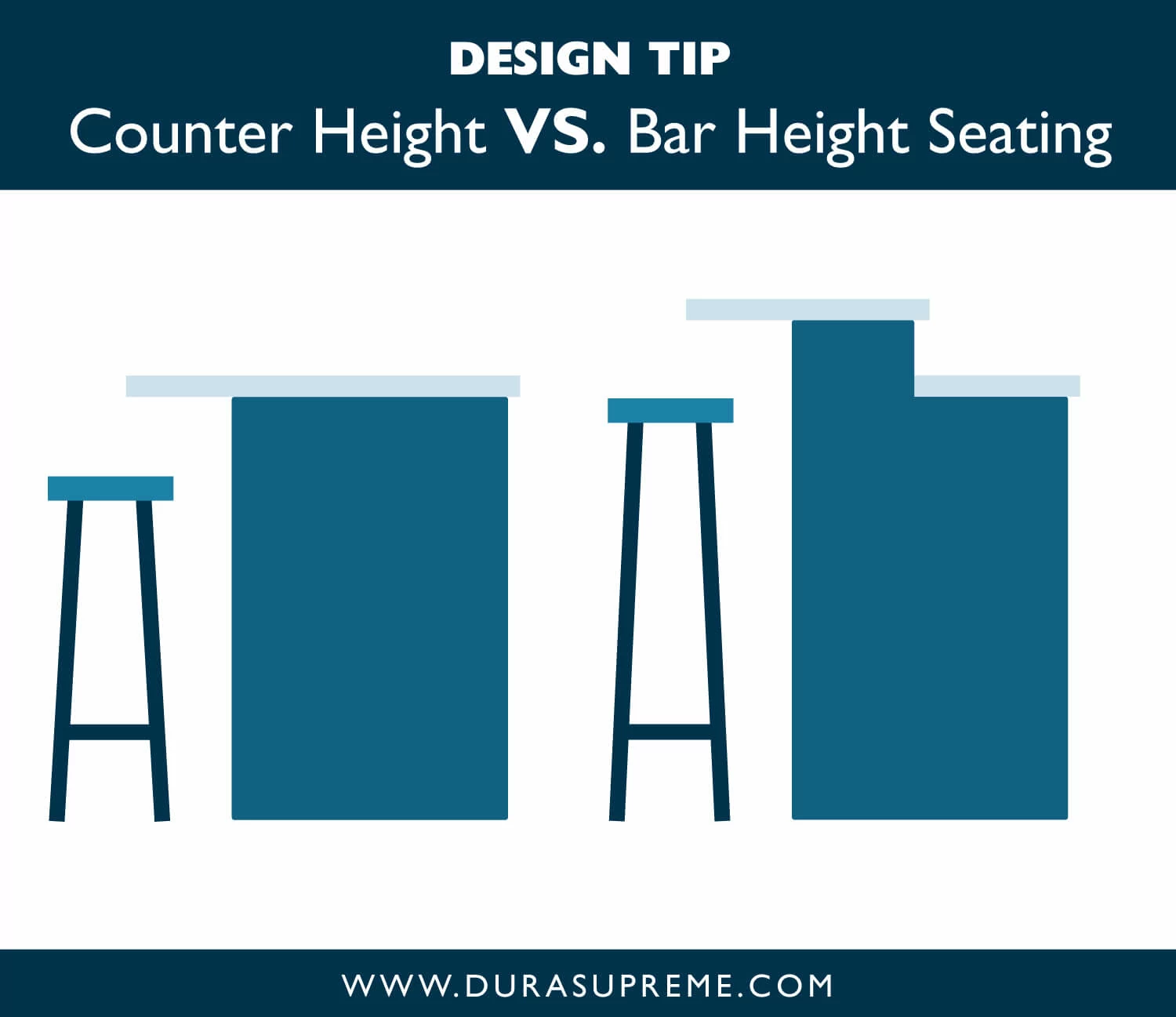When designing or remodeling a kitchen, one common decision people face is choosing between countertop height vs bar height. While they might look similar at first glance, the difference between the two can impact comfort, function, and the overall look of your space. Let’s break down how these two heights differ and how to decide which is best for your needs.
What Is Standard Counter Height?
The standard counter height in most kitchens is 36 inches (91 cm) from the floor to the top of the countertop. This measurement has become a norm because it works well for tasks like chopping, mixing, and cooking. Most base cabinets are about 34.5 inches high and are topped with a 1.5-inch thick countertop, giving you that standard total.
This height is perfect for everyday kitchen activities and is considered ergonomic for the average adult. It’s also ideal for counter height seating, such as stools that are 24 to 26 inches high, allowing your knees to fit comfortably under the surface.
What Is Bar Height?
On the other hand, bar height countertops typically stand at 42 inches (107 cm) high. This is six inches taller than standard counters and is often used for raised eating or entertaining areas, especially on kitchen islands or peninsula extensions.
To pair with this height, you’ll need bar height stools that range from 28 to 30 inches. These taller counters can add visual separation between kitchen workspaces and living areas in open-concept homes, making them a stylish choice.
Counter Height vs. Bar Height Stools
Choosing the right stool is just as important as choosing the counter. Counter height stools usually measure 24 to 26 inches, perfect for sliding under a 36-inch counter. In contrast, bar height stools range from 28 to 30 inches to accommodate the taller surface.
Mixing the wrong height stool with the wrong surface will leave you either too high or too low, making dining uncomfortable and awkward. If you’re buying seating online or in-store, always double-check the dimensions and match them properly.
Functional Differences Between Counter and Bar Heights
Understanding the functional differences can help you choose what works best:
- Food Prep vs. Socializing: Countertops are designed for prep work, offering a comfortable level for chopping, stirring, and rolling dough. Bar counters, meanwhile, create a dedicated zone for serving drinks or casual meals.
- Family-Friendly: Standard kitchen counter height is more accessible for kids, older adults, or those with mobility concerns. Bar height may be challenging for children or those in wheelchairs.
- Visual Design: Bar-height counters add vertical interest, creating a layered look. They’re also great for hiding kitchen messes from guests in adjoining rooms. Standard counters offer a cleaner, more open appearance.
Kitchen Island Design Considerations
Many kitchen islands combine both heights in a two-tier format. The lower counter section is used for prep, while the raised bar height portion functions as an eating or serving area. This multi-level design works well in open-concept homes where the kitchen flows into the living room.
But be cautious: two-tier islands require more space and can sometimes disrupt the visual flow in smaller kitchens. If you prefer a more unified look, a single-level island at countertop height might be a better fit.
Countertop Height Guide for Various Rooms
While kitchen counters are typically 36 inches high, the right height can vary depending on the room:
- Bathroom countertops are often shorter, around 30 to 34 inches, due to the lower sink use.
- Laundry room counters sometimes go higher (up to 39 inches) to reduce bending over while folding clothes.
- Garage workbenches might be taller for heavy-duty tasks.
Each space benefits from a different setup depending on how you use it.
Ergonomics and Comfort
Height impacts kitchen design ergonomics. A countertop that’s too low may strain your back, while one that’s too high could tire your arms. Think about your height and how you move around the kitchen.
For people taller than 6 feet, raising the standard counter height by an inch or two can significantly improve comfort. On the flip side, shorter individuals might benefit from slightly lower counters.
If you’re planning a custom kitchen, this is a great opportunity to customize countertop height based on your personal needs.
Countertop Height for Wheelchair Accessibility
When designing a kitchen for wheelchair users, the counter height is usually lowered to 34 inches or less. It also requires open space underneath to allow for legroom, along with adjusted cabinet heights.
If accessibility is important for your household, consult ADA (Americans with Disabilities Act) guidelines or local building codes to ensure compliance.
Countertop Height Trends in Modern Kitchens
Today’s kitchen trends are about both form and function. Here are a few rising ideas:
- Single-level islands at standard counter height are replacing tiered designs for a sleeker look.
- Waterfall countertops, where the material continues down the sides, look more elegant at a lower, uninterrupted height.
- Some homeowners are using bar height tables as mobile or standalone kitchen pieces to double as workspaces or breakfast nooks.
No matter what’s trending, always prioritize what fits your daily life.
Counter Height vs. Bar Height Table
When it comes to dining tables, counter height tables (36 inches) offer a casual vibe, great for open layouts and quick meals. They work with the same stools used for counters, keeping things uniform.
Bar height tables, standing at 42 inches, give a pub-style feel. They create a more formal or lounge-like setting, great for entertaining adults but less practical for kids.
So, if your space is family-oriented or you’re aiming for multi-use functionality, go with counter height furniture. For a sleek bar look, bar height wins.
Bar Height Benefits (And Limitations)
Pros:
- Adds a stylish focal point to open kitchens
- Great for separating work and social zones
- Perfect height for adult guests and bar entertaining
Cons:
- Harder for kids and seniors to use
- Requires taller, often more expensive stools
- Can block open sightlines in smaller spaces
Final Thoughts
The choice between countertop height vs bar height really depends on your kitchen’s purpose, your personal comfort, and your home’s overall design. If you’re all about prep space, practicality, and family-friendly function, standard counter height is the way to go. But if entertaining, stylish separation, and visual drama are high on your list, a bar height countertop or table might be your best bet.
Whatever you choose, make sure it fits how you live. Match your stool height, think about daily use, and consider blending both heights in kitchen island designs if space allows. Your countertop shouldn’t just look good—it should feel right too.


